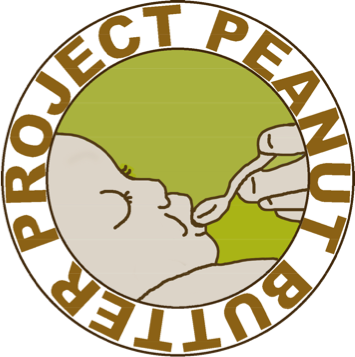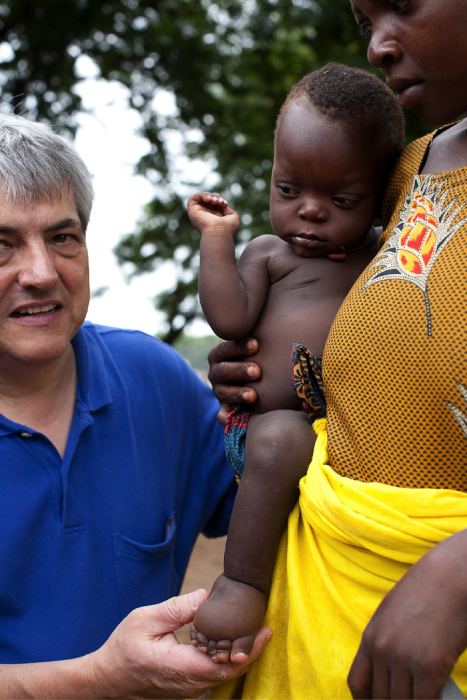Here are the answers to some of our most frequently asked questions.
What is the origin of the name “Project Peanut Butter?”
In 2002, when RUTFs were recognized as life-changing, Dr. Manary and his family returned to America from Africa determined to raise money to continue a program. There was no specific name for the project at first, except "the-RUTF-research-program". A woman at the Manary's church and Dr. Manary's great-aunt began to refer to the program as the "Peanut Butter Project", describing the basic ingredient in the food. This evolved into Project Peanut Butter, and the organization took the name officially 2004, when it was legally established as a nonprofit.
Why do some starving children look bloated?
Many children who are starving appear "bloated" due to a fluid shift in their bodies (a healthy person's bodily fluid does not shift in this way). The medical term for this condition is "edema". The exact science behind edema is not well understood and appears to be complex, but edema is a sign of severe acute malnutrition. It is associated with famines, particularly in African nations.
Why don’t families practice birth control if their children are starving?
Family size in the countries with high rates of malnutrition is typically high. At one point in many societies, the number of children in a family was equated with wealth or even degree of supernatural blessings. Although this is not as much a factor in these countries today, parents still rely on a large family to help with work and to keep the family from starvation. With high infant and under-five morality rates, parents are less likely to limit the number of children they have. Research shows that birth rates in societies drop AFTER childhood survival rates improve. By improving the child survival rate, Project Peanut Butter strives to increase the likelihood that parents will have smaller families.
Won’t these children become malnourished again after completing therapy with RUTF?
It is true that once recovered from severe malnutrition, many children do continue to live in extreme poverty, but only rarely do they again succumb to malnutrition. PPB research shows that less than ten percent of severely malnourished kids will relapse. Why? Once restored to health with RUTF, a child has built up a nutritional reserve. Even when faced again with a hungry period or an infection, a child who has recovered earlier with the use of RUTF typically has enough strength and nutrition to fight through additional periods of food shortage.
Where else in the world is RUTF produced, and who else produces it?
RUTF is produced in many countries around the world, in both developed nations and locally. For-profit companies and nonprofit organizations alike manufacture the food. Many international aid organizations, including UNICEF, Clinton Health Access Initiative (CHAI), and Doctors Without Borders (MSF), purchase RUTF from suppliers and use it in their local programs.
Does RUTF go by any other names?
Ready-to-Use Therapeutic Food (RUTF) is a generic name for a product that has a specific nutritional makeup proven to bring malnourished children back from the edge of starvation. It may go by any number of “brand” names, depending on what company produces it. Many people have heard of “Plumpy’nut,” which is produced by a major France-based RUTF manufacturer called Nutriset. Project Peanut Butter’s product is known locally as “Chiponde” in Malawi and “Dutasi” in Sierra Leone. All of these foods are classified as RUTF, though their exact formulas may differ slightly.
Why don’t we hear about malnutrition on the news if it is such a huge problem?
Malnutrition is a silent epidemic, typically affecting the poorest people in the world. Even though malnutrition is a major cause of death among children worldwide, it is a chronic condition of the poor and therefore does not attract much attention from those of us safe from its grasp.
How does PPB decide which countries to work in?
The Manary’s chose Malawi for the first field trials because it was a country where they had previously lived and worked. Dr. Manary had familiarity with the medical system of the country and was an adjunct professor at the Malawi College of Medicine. It was a natural progression to spread PPB's work on the same continent, but in general, PPB looks for certain things in a country before deciding to set up RUTF production there. These things may include the local availability of RUTF ingredients in the quantities PPB requires, the presence of high quality suppliers and processors of raw materials, a favorable business climate that facilitates legal establishment, the availability of industrial level utilities and trained personnel, the presence of internationally accredited laboratories for product testing, political stability and safety, support from local and international aid organizations, and, of course, a genuine need for a local producer of RUTF. It is PPB’s hope that other nonprofits and governments will attack malnutrition using RUTF in the many other countries where it is needed.
Does PPB encounter many children with peanut allergies?
No. RUTF has been used to treat millions of malnourished children around the world, and the reported cases of peanut allergy have been very few. Many citizens of developed countries are surprised to hear this, since peanut allergies are increasingly prevalent in some parts of the world. There are a few theories for why we don’t see many peanut allergies among malnourished children. An allergic reaction is basically a person’s immune system overreacting to foreign matter that it perceives as potentially harmful. The immune system of a malnourished child is very active already because the child is very sick, so it typically would not even recognize peanuts as a threat or expend the extra energy to tackle such a thing. We must also consider the environment in which typical malnourished children grow up; it is more than likely not nearly as sanitary as that of children who grow up developed nations. Kids in African nations are frequently exposed to a variety of pathogens and “foreign material” at a young age, as they spend more time outdoors and eat whatever is available. Their immune systems are thus conditioned to fight more dangerous pathogens and would not recognize peanuts as an allergen.
Where does PPB get its funding?
PPB receives a large portion of funding from grants and private foundations. We also rely heavily on individual donations from our supporters.
Does PPB only treat severely malnourished children?
Since the majority of cases of severe acute malnutrition are found in children ages 6 months to 5 years, this is the major focus of PPB’s work. However, Dr. Manary and other investigators are constantly conducting research to better understand how to treat malnutrition in other groups of people. These groups include moderately malnourished children, malnourished adults, pregnant women, and adults living with HIV/AIDS and Tuberculosis. Project Peanut Butter does treat moderately malnourished children in addition to severely malnourished children at our mobile clinics.
If you have an additional question about Project Peanut Butter that has not been answered above, please don't hesitate to send your question to info@projectpeanutbutter.org. Thank you.

